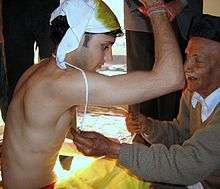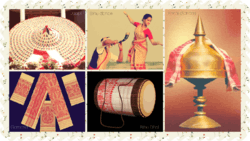Assamese Brahmins
 | |
 | |
| Total population | |
|---|---|
| 700,000 | |
| Languages | |
|
• | |
| Religion | |
|
| |
| Related ethnic groups | |
| Indo-Aryan peoples, Brahmin, Barooah, Sarma, Gain, Chakrabarty, Goswami, Bordoloi |
Assamese Brahmins (Assamese: অসমীয়া ব্ৰাহ্মণ, Sanskrit: असमिया ब्रह्म) also called Bamuns (বামুন), by the locals, constitute the Indo-Aryan community of the Assam Valley belonging to the Vedic Brahmin caste. Brahmins are found everywhere in Assam and surrounding areas however, most predominantly in Jorhat, Nalbari, Barpeta, Goalpara, Dibrugarh, Nagaon, Sonitpur, Tinsukia and Darrang districts. Brahmins of the valley also have a significant diaspora in the rest of the mainland India, mainly in Delhi, and are considered to be at the apex of eastern India's caste hierarchy. Common surname families include: Acharjee / Acharya, Adhyapok, Barua / Baruah, Bhatta, Gain / Gayen, Goswami / Goswami, Thakur / Borthakur, Sharma / Sarma, Phukan, Rajkhowa etc.
Description
Brahmins of Assam Valley belong to the group of Indo-Aryans, having their origin as far as West Bengal to Kannauj.[1] There is a myth that the Ahoms brought the Brahmins to Assam for worshiping goddess Kamakhya but the fact is that Brahmins were present in Assam much earlier to the advent Ahoms and hence also known as Kamrupi Brahmins. During the reign of Koch Kings the Kamrupi Brahmins were quite prosperous. In fact one of the earliest king of the Ahom Dynasty is known as Bamuni konwar as because he was brought up by a Brahmin family and till that time the Ahom kings were not Hindu and as such there is no question of Ahoms inviting Brahmins to Assam. Although Brahmins in Assam are similar as per their faith and customs with that of any other Brahmin community across India but they are predominantly Saakta or worshiper of Shakti and are non-vegetarian. The practice of animal sacrifice is also common among Assamese Brahmins. Certain regional beliefs, customs and practices also exist which are tribal in nature and are distinct to the Assamese Brahmins.
Each Brahmin family within the community belongs to a specific Gotra (গোত্ৰ) (Brahmin identity surname) which is unique to a family thereby indicating their origin or the Lineage. Many of the Assamese Brahmins write the conferred titles either gifted by the Ahom kings or adopted being in Assam for a long time.
Tradition
Assamese Brahmins, like rest of the sect elsewhere in mainland India, adheres to legacy practices of Hinduism. One may realize religious adherence to the aspects of Puja (পূজা), Temple (মন্দিৰ, দেৱালয়), Murti (মুৰ্তি), Bhakti (ভক্তি), Japa (জাপ), Bhajana (ভজন), Yajna (যগ্য), Homa (হোম), Tirthadana (তীৰ্থদান), Vrata (ব্ৰ্ত), Prāyaścitta (প্ৰায়চিত্ত), Tirtha (তীৰ্থ), Matha (মঠ).
Unlike Brahmins elsewhere, Assamese Brahmins appear less rigid in their religious practices and are more close to tribal culture and nature. For example, their dietary regime include non-vegetarian food, such as Eggs, Fish, Chicken, Duck, Pigeon's meat and Mutton; wild animals and birds like deer, tortoise, migratory birds etc less likely consumed by Brahmins elsewhere. It may be also common to see a fewer Brahmins worshipping saints of Asamiya community equally as a part of their religious curriculum.
Lagundeoni

Traditionally, the ceremony of Lagundeoni (লগুণদিয়নি) - one of the Sanskaras (সংস্কাৰ) or rites of passage marking acceptance of a student by a Guru (গুৰু), is a quite prevalent ritual within the community. A sacred thread - Lagun (লগুন), given by a Pujari (পূজাৰী) during the ceremony is a symbolic reminder to the young male born to the Brahmin family of his purpose at school, as well as a social marker of the student as someone who has embarked his journey into formal education, where education itself is not limited to ritual and philosophical speculations, but extends to all practical aspects of culture and life in general. The ceremony is typically performed between ages 12 – 14 among Brahmin males.
Pujas
In variably most Brahmin families are involved in performing religious rituals, known as Pujas (পূজা). Brahmins show reverence by performing rituals / pujas to a wide spectrum of gods and goddesses of Hinduism, such as Ganesha (গণেশ), Hanuman (হনুমান), Kamakhya (কামাখ্যা), Navagraha (নৱগ্ৰহ), Saraswati (সৰস্বতী), Satyanarayana (সত্যনাৰায়ণ), Shani (শনি), Shiva (শিৱ), among others.
Some of these rituals may be performed at some occasions in a year, however, a few others may be performed every year as part of continued legacy of worshipping a family deity. These traditions are generally passed on to generations and hence it is not uncommon to see a Brahmin family engaging in rituals that may be as old as 500 years of age or beyond.
Durga Puja
Durga Puja is performed among some Brahmin families which may or not include Murti Sthapana (মুৰ্তি স্থাপনা) in their homes. Traditionally, the ritual celebrates worship of the Hindu goddess Durga (দেৱী দুৰ্গা) and is observed as Saptami (সপ্তমী), Ashtami (অষ্টমী), Nabami (নৱমী) and Dashami (দশমী) (where, Nabami and Dashami concluding in a day).
In Asamiya (অসমীয়া), the goddess "Durga" has been described as follows:
| “ | দৈত্যনাশার্থবচনো দকাৰঃ পৰিকীর্তিতঃ। উকাৰো বিঘ্ননাশস্য বাচকো বেদসম্মত।। |
” |
- ^ পূজা-বিজ্ঞান, স্বামী প্রমেয়ানন্দ, উদ্বোধন কার্যালয়, কলকাতা, ১৯৯৯, পৃষ্ঠা ৪৪
অর্থাৎ, ""দ" বৰ্ণই দৈত্য বিনাশ কৰে, উ-কাৰে বিঘ্ন নাশ কৰে, ৰেফে ৰোগ নাশ কৰে, "গ" বৰ্ণই পাপ নাশ কৰে আৰু অ-কাৰে শত্রু নাশ কৰে। ইয়াৰ অর্থ, দৈত্য, বিঘ্ন, ৰোগ, পাপ আৰু শত্রুৰ হাতৰ পৰা যি ৰক্ষা কৰে, তেঁৱেই দুর্গা।" আনহাতে শব্দকল্পদ্রুমত কৈছে, "দুর্গং নাশয়তি যা নিত্যং সা দুর্গা বা প্রকীর্তিতা"। অর্থাৎ, যি দুর্গ নামে অসুৰক বধ কৰিছিল, তেঁৱেই সকলো সময়ত দুর্গা নামে পৰিচিত।
Jagaddhatri
Goddess Jagaddhatri (জগধাত্ৰী) worshipped among Brahmins starts on Asthami tithi (অষ্টমী তিথি) and ends on Dashami tithi (দশমী তিথি).
Jagaddhatri literally means Holder (Dhatri) of the World (Jagat).
Lakshmi Puja
Some Brahmins of Assam show reverence to the Goddess Lakshmi by performing Lakshmi Puja (লক্ষ্মী পূজা) in their homes every year. They pray for prosperity and well-being for their families and businesses and involves Sculpture installation of Lakshmi idol or Murti with Bhakti, Japa, Bhajana, Yajna, Homa (ritual). Where the rest of the mainland India performs Lakhmi Puja during Diwali (দিৱালী), Assamese Brahmins perform this ritual after Diwali on full moon night.
Raas Puja
Much like Lakshmi Puja, some families adhere to Radha Krishna (ৰাধা – কৃষ্ণ) as their family deities and show reverence to the god and goddess as the supreme power of all. Raas Puja (ৰাশ পূজা) is performed in the later Autumn spanning across 2 days - Adhibash (অধিবাশ), followed by Puja (পূজা) in the subsequent day.
-
Image of Goddess Durga (দুৰ্গাৰ প্রতিমা)
-
Image of Goddess Jagaddhatri (জগধাত্ৰীৰ প্রতিমা)
-
Image of Goddess Lakshmi (লক্ষ্মীৰ প্রতিমা)
-

Image of Raadha – Sri Krishna (ৰাধা – শ্রীকৃষ্ণৰ প্রতিমা)
| Part of a series on the |
| Culture of Assam |
|---|
 |
|
Protohistoric
Ancient Medieval Colonial |
|
|
|
|
|
|
Festivals
|
| Religion |
|
History
Archives
Genres
Institutions Awards Asam Sahitya Sabha Award • Kamal Kumari Foundation Award • Krishnakanta Handique Award |
|
Music and performing arts |
|
Surname families
1. Barua, Baruah, Barooah, Baroova, Borooah (বৰুৱা) or other spellings of the same surname.
Variations within Barua incorporating middle names / titles / prefixes are appended below:
*Bez - Baruah / Barooah (বেজবৰুৱা)
*Bor/Bar - Baruah / Barooah (বৰবৰুৱা)
*Bujar - Baruah / Barooah (বুজৰবৰুৱা)
*Chandra - Baruah / Barooah (চন্দ্ৰ বৰুৱা)
*Ram/Raam - Baruah / Barooah (ৰাম বৰুৱা)
*Ranjan - Baruah / Barooah (ৰঞ্জন বৰুৱা)
*Prasad - Baruah / Barooah (প্ৰসাদ বৰুৱা)
*Govind / Govinda - Baruah / Barooah (গোবিন্দ বৰুৱা)
*Krisnakant/Krishnakanta - Baruah / Barooah (কৃষ্ণকান্ত বৰুৱা)
2. Bezborah (বেজবৰা)
3. Acharya / Acharjee (আচাৰ্য)
4. Bhatta / Bhattacharya (ভট্টাচাৰ্য)
5. Bhagawati / Bhagwati (ভাগৱতী)
6. Bardoloi / Bordoloi / Bardalai (বৰদলৈ)
7. Bor / Bar - Kotoki / Katakey / Kataki / Pujari / Poojari / Puzari (বৰকটকী, বৰপূজাৰী)
8. Bor / Bar - Thakur / Thakore also, very rarely Borethakur/ore (বৰঠাকুৰ)
9. Chakravarti / Chakraborti (চক্ৰৱৰ্তী)
10. Gain / Gayen (গায়েন, গায়ন)
11. Goswami (গোস্বামী)
12. Khaund / Khaound (খাউন্দ)
13. Kotoky / Katakey (কটকী)
14. Pujari / Poojari / Puzari (পূজাৰী)
15. Phukan / Phookan (ফুকন)
16. Rajkhowa (ৰাজখোৱা)
17. Sarma / Sarmah / Sharma (শৰ্মা)
18. Siddhant / Siddhanta (সিদ্ধান্ত)
19. Savapandit (সভাপণ্ডিত)
20. Soud (সভাপ)
21. Thakur / Thakore (ঠাকুৰ)
22. Pathak (পাঠক)
23. Rajguru / Razguru (ৰাজগুৰু)
24. Tamuli (Sarma Tamuli) (শৰ্মা তামুলী)
Although it is uncommon, apart from the above, other surnames (mostly written by Kalitas), such as Changkakati, Chaliha, Khatoniar, Choudhury, may be written by a fewer Brahmins rarely. Surnames, such as Baruah are equally present among non-Indo-Aryan communities, such as Ahoms and Sutiyas, and Kalitas; whereas Rajkhowa and Phukan are common to Ahoms and Kalitas alike, although it's unusual to see Baruah to be spelled as Barooah by Ahoms.
Gotras
In Hindu society (হিন্দু ধৰ্ম সমাজ), the term gotra means clan. It broadly refers to people who are descendants in an unbroken male line from a common male ancestor or patriline. Generally the gotra forms an exogamous unit, with the marriage within the same gotra being prohibited by custom, being regarded as incest.
Some of the most common Assamese Brahmin gotras are listed below:
- Atri - Krishnatriya (আত্ৰে – কৃষ্ণাত্ৰেয়)
- Bhadraj / Bharadwaaj / Bhardwaj / Bharadwaj (ভদ্ৰাজ)
- Bhargava / Bhargav (ভাৰ্গৱ)
- Garga / Gargya / Garg (গাৰ্গ)
- Gautam (গৌতম)
- Kashyapa / Kashyap) (কাশ্যপ)
- Kaushik (কৌশিক)
- Kondinnya / Kondolya (কোনদিন, কোনদিন্য)
- Katyayana (কত্যায়ন)
- Kapil / Kopil (কপিল)
- Madhukalya (মধুকুল্য)
- Mihirayan (মিহিৰয়ন)
- Parasara / Porasor / Parasor (পৰাশৰ)
- Sandilya / Chandilya / Shandilya (সানদিল্য)
- Rishi Alambh / Alambayan / Alamayan / Alimman / Alabyan / Alamba (ঋষি আলম্ব, ঋষি আলম্ভ)
- Vasistha / Bashistha / Vashistha (ৱশিষ্ট)
- Vatsyayan / Bashyas / Batsyas / Vachyas (বাৎস্যায়ন, ৱাৎস্যায়ন, বাতস্য, ৱাতস্য)
See also
References
- ↑ http://online.assam.gov.in/web/guest/historyofassam?webContentId=109367
- ↑ "Meet the Axomiya Sikhs". The Tribune. Chandigarh. 24 March 2013.
